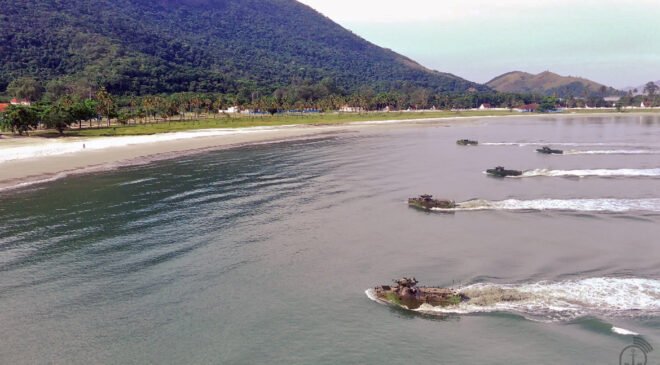The background of Operation UANFEX-2022 was Ilha da Marambaia, in Rio de Janeiro. Between the 21st and 24th of November, the scenario was composed of 880 military personnel employed in different naval means: Multipurpose Dock Ship “Bahia”, Ocean Support Ship “Purus”, 10 Amphibious Caterpillar Cars, two helicopters, one UH-15 “Pégasus 02” and an SH-16 “Warrior 36” and Unloading Vessels for Vehicles and General Cargo.

Considering the plot of the Operation based on a humanitarian aid situation, the exercise also had a significant participation of Marines assets, which included the Landing Force, the Navy Expeditionary Medical Unit, as well as SK-105A2S combat vehicles and a howitzer battery 105 mm Light Gun.
In a peculiar way, the exercise tested the ability of a naval force, already at sea and previously loaded with troops and material, to plan the response to an emergency situation overseas. In this UANFEX, unlike other operations this year, the military was subjected to the plot of the exercise with the ships already away from the host port. During training, the information received was that it was necessary to reinforce aid to the population of an isolated country, where an international body, equivalent to the UN, was not yet fully established and, therefore, remained under threat from hostile groups.
The challenge lay in assessing the terrain, identifying imminent threats, mapping the action of the military and naval assets, planning access to the location where the population was, entering and leaving the affected area safely, identifying the wounded and the necessary removals. , within 24 hours, safeguarding human life and keeping the Peacekeeping Force active.
After this planning, the action culminated in an Amphibious Incursion, in the Marambaia area, at dawn on November 23rd. This is how UANFEX-2022 was developed and, when talking to those responsible for the exercises, it was possible to perceive the importance of the Operation. Admiral of the Fleet (FN) Armando, General Commander of the Marine Corps, stated that the “opportunity that we have here on Marambaia Island to carry out amphibious exercises is spectacular because we combine our naval assets and the Marine Corps troops, employing live ammunition (Howitzer and Machine Gun).” The Admiral reinforced that “the use of live ammunition for the Marines is extremely important. I could say it’s vital. We are an extremely professional troop and proof of that is the intensive use of live ammunition. And here on Ilha da Marambaia, we have been using artillery for some time now. In the past, we used mortar and handguns, but now we are also using the battery 105 light gun. So, the possibility that we have to carry out amphibious projection type exercises, an exercise with a smaller magnitude, is important because the problems that occur are real and will have to be solved during its execution. It is a very big gain every time the Marine comes from the ship to land. It is an amphibious unit that is our raison d’être!” it is important because the problems that occur are real and will have to be solved during its execution. It is a very big gain every time the Marine comes from the ship to land. It is an amphibious unit that is our raison d’être!” it is important because the problems that occur are real and will have to be solved during its execution. It is a very big gain every time the Marine comes from the ship to land. It is an amphibious unit that is our raison d’être!”
The disembarkation of the Marines allowed the setting up of an Advanced Trauma Unit (ATU), monitored by the Navy’s Expeditionary Medical Unit. Captain of Sea and War (FN) Gláucio, Commander of the Logistical Battalion of Marines, emphasized that the military are prepared to meet the demands of health and civil affairs. To this end, he explained how a logistical structure was set up, with tents and a UAT, which reinforces the capacity for action and quick employment of the Marines.

